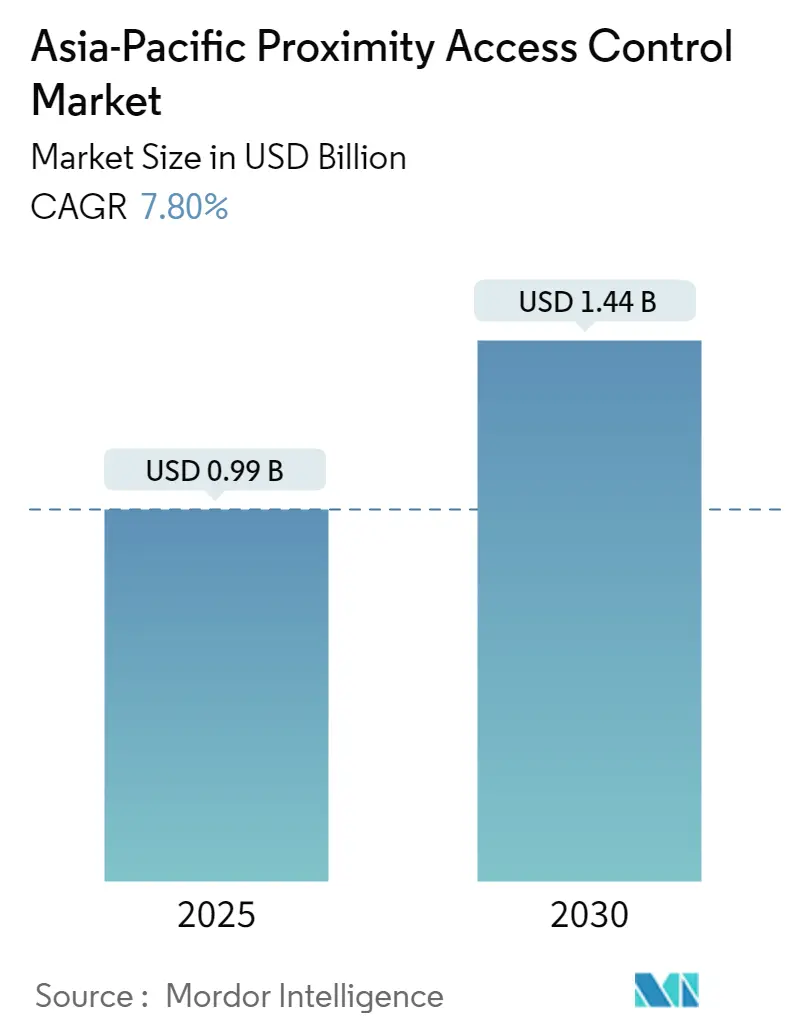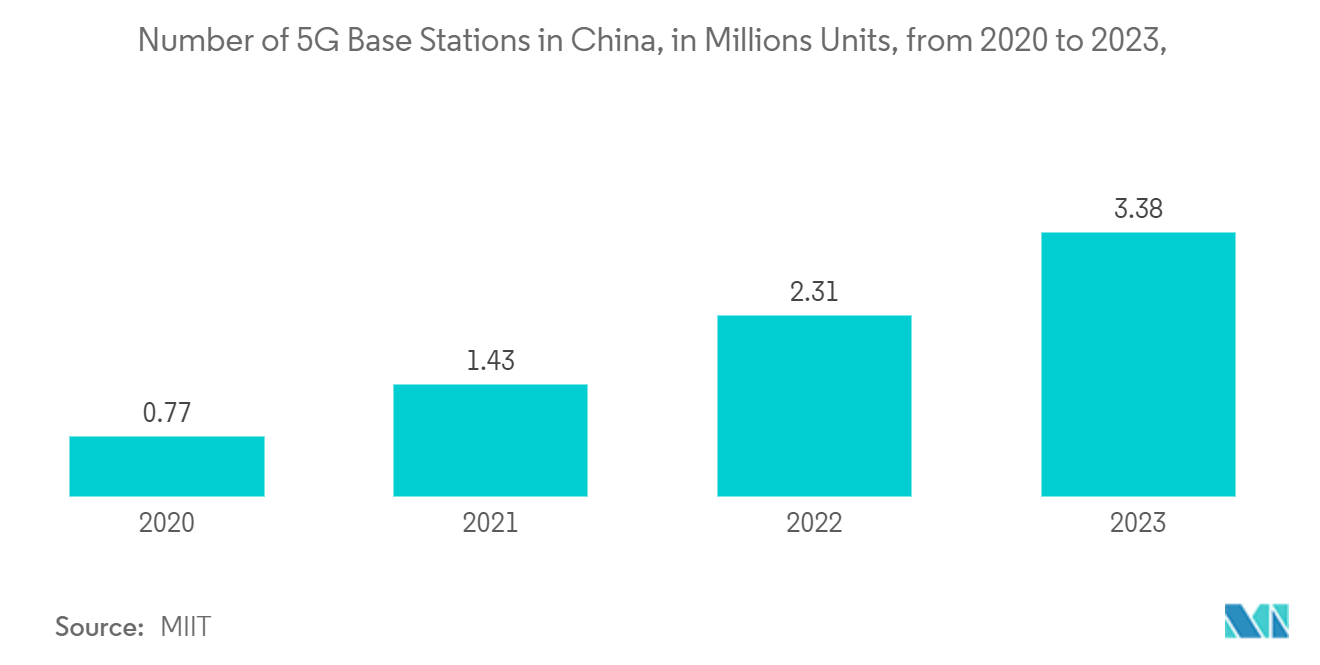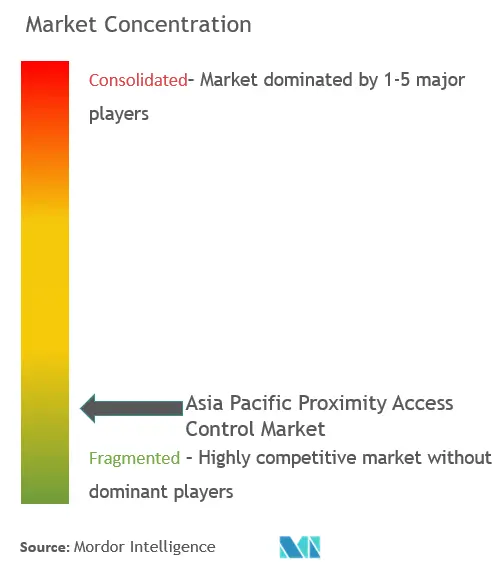Asia-Pacific Proximity Access Control Market Size and Share

Asia-Pacific Proximity Access Control Market Analysis by Mordor Intelligence
The Asia-Pacific Proximity Access Control Market size is estimated at USD 0.99 billion in 2025, and is expected to reach USD 1.44 billion by 2030, at a CAGR of 7.8% during the forecast period (2025-2030).
- The rapid urbanization and the development of residences and commercial establishments in countries such as India, China, and Japan have created a demand for proximity access control systems to control entry and security effectively. Proximity card readers enable contactless card reading, promoting hygienic access control for regular use. United Nations projections indicated that by 2050, the global urban population will surpass its rural counterpart. India's urban population is set to surge by 328 million between 2022 and 2047, a figure exceeding the entire population of the United States.
- Further, increasing security concerns and a corresponding rise in security budget allocations are poised to drive significant growth in electronic access control system sales. According to the National Crime Records Bureau (NCRB), India's reported crime rate in 2023 was 445.9 per 100,000 individuals. Theft was the most common crime, followed by robbery and assault. Similarly, the National Police Agency of Japan reported that in 2023, there were approximately 44.23 thousand instances of grand theft, with nearly 17.5 thousand of these occurring in non-residential properties.
- The accessibility of commercial properties is highly dependent on access control systems. Proximity readers have become increasingly popular across all commercial properties. A significant number of businesses have already adopted proximity access control systems as a means of allowing authorized personnel to access the premises. This system is highly adaptable and can be designed to the needs of each business. The emergence of heightened security concerns, both in private companies and public settings, has necessitated the implementation of advanced access control solutions to safeguard individuals and resources.
- Additionally, customers are drawn to proximity access control systems due to the development of biometrics, blockchain, wireless connectivity, and other technologies. Additionally, biometric security is a significant investment in developing production facilities. Biometric technology, known for its effective identification, authentication processes, and enhanced security for information systems, is gaining popularity, especially for controlling access to electronic resources.
- Further, a smaller card reading range will restrict the adoption of these types of cards for access control, as if a proximity card reader has a limited read range, users may face difficulties in card usage. The market's growth is hindered by a need for more awareness of the advantages of contemporary security solutions and the high installation costs associated with workplace access control systems.
- Additionally, data privacy and security concerns, particularly in Asia Pacific with strict data protection regulations, may impede the implementation of proximity access control systems that store sensitive user data.
- Further, the ongoing war between Russia and Ukraine has disrupted the global supply chain, particularly affecting the availability and cost of electronic components and raw materials used in access control systems. This is leading to delays in production and increased costs for manufacturers. The rising inflation rates have increased the cost of goods and services, including proximity access control systems. Higher costs are leading to reduced purchasing power for consumers and businesses, slowing down the market's growth.
Asia-Pacific Proximity Access Control Market Trends and Insights
The Biometric Scanners Segment is Expected to Hold a Significant Market Share
- Biometric technology is a rapidly expanding proximity security solution. It enables the identification of a user's physical characteristics to provide controlled physical access to infrastructures. This advanced technology is becoming increasingly popular in banking and financial services, transportation and logistics, commercial enterprises, government institutes, and residential sectors. Speech and facial recognition are contactless, non-threatening, and user-friendly biometrics technologies. The non-contact nature of the identification and authentication process encourages individuals to invest in more biometric readers.
- Biometric identifiers such as fingerprints, irises, and facial scans offer a heightened level of security compared to PIN or key-operated locks. This heightened level of protection is a significant factor for individuals and companies seeking to safeguard their properties and assets effectively. In 2023, fingerprint recognition was the most common identification method for smart door locks in China, as it was present in all smart door locks available on the market. Additionally, facial recognition was used in 16% of smart door locks.
- Biometric scanners are employed to control passports and conduct immigration procedures, thereby improving border security and speeding up the processing of travelers. For instance, in June 2024, Bengaluru International Airport Limited (BIAL) introduced India's pioneering biometric self-bag drop service. Previously, travelers at the airport's self-bag drop had to print their boarding passes at self-check-in kiosks. Subsequently, these passes were scanned to kickstart the bag drop procedure. Through Digi Yatra, which leverages facial recognition biometrics, domestic flyers can now move through airports sans a physical boarding pass or identification.
- Asia-Pacific is increasingly adopting biometric technology for authentication due to the recent advances in the field. For instance, Japan's Seven Bank will enable customers to deposit and withdraw funds through facial recognition at approximately 20,000 ATMs nationwide by March 2024. For facial authentication to be effective, customers must first link the account details to their biometric data at an ATM operated by Seven Bank. As Seven Bank depends on ATM charges from other banks, other banks are expected to follow suit to enable their customers to utilize facial recognition at the ATMs.
- The increasing 5G network connectivity in countries such as India, China, Japan, and South Korea creates ample opportunities for wireless proximity access control systems. For instance, according to MIIT, by the end of 2023, the number of 5G base stations in China amounted to 3.38 million. With extensive infrastructure investments and ambitious rollout plans, China has achieved significant 5G coverage. According to forecasts, the number of base stations is projected to reach over six million by 2024.

India is Expected to Witness Significant Growth
- India's increasing emphasis on intelligent buildings and infrastructure access control systems is essential for establishing secure, functional, and connected spaces. According to the Government of India, by 2030, approximately 40% of the population in India is expected to live in urban areas and contribute 75% of the country's GDP. The government has allocated INR 7,20,000 crore (USD 86.35 billion) for this scheme, with an average of INR 100 crore (USD 12.0 million) per city for the first five years. This scheme will be implemented as a CSM on a 50-50 basis, with the central government contributing INR 50 crore (USD 6.0 million) and the state or union territory governments contributing INR 50 crore.
- In Asia-Pacific, countries like India have developed the world's most comprehensive biometric database through initiatives such as the Aadhaar Card System. Implementing Aadhaar-based authentication provides an additional layer of security for access control systems. According to UIDAI, as of December 2023, approximately 1.3 billion Aadhaar identification cards were issued in India. In FY2023, around 36.9 million Aadhaar cards were issued in India. It is the most comprehensive biometric identification system implemented by the Indian government.
- The rise of affluence and the aspiration for a more modern lifestyle has resulted in a greater prevalence of access control systems for residential complexes in India, both in terms of convenience and security. The growing wireless network connectivity and 5G network across the country accelerates the adoption of wireless access control systems such as proximity access control.
- The proximity access control market is expected to experience a surge in demand due to the increasing prevalence of access control systems in various sectors, such as retail, hospitality, hospitality, airports, ATMs, banking, residential, and religious institutions in India. Furthermore, the heightened risk of terrorist attacks, increased crime rates, and India's low police-to-population ratio are likely to stimulate the access control market further.
- Moreover, the proximity access control segment is growing as consumers become increasingly interested in utilizing cost-effective security solutions. Finally, the demand for wireless and Internet of Things (IoT)-based security systems across various applications is expected to propel the access control market.

Competitive Landscape
The Asia-Pacific proximity access control market is fragmented. The market is highly competitive and has several players. Companies in the market are continuously trying to increase their market presence by introducing new products, forming strategic partnerships, expanding their operations, mergers and acquisitions, and collaborations. Some of the major players are Identiv Inc., Hangzhou Hikvision Digital Technology Co. Ltd, Johnson Controls, Dahua Technology Co. Ltd, Avigilon (Motorola Solutions Inc.), Honeywell International Inc., Schneider Electric, Verkada Inc., Innovatrics, Vicon, Idemia, and SALTO Systems.
- February 2024: Hikvision launched its latest line of professional access control products. This includes the DS-K1T805 & 502 series vandal-proof access control terminals, the DS-K1109 series reader, and the DS-K2700X series access controller. The DS-K1109 series reader supports mobile access technologies, including NFC, QR codes, and Bluetooth.
- March 2024: Allegion announced the introduction of the Schlage XE360 Series Wireless Locks, an electronic lock collection tailored to meet the demands of the multifamily market. This new series represents the latest advancement in electronic lock technology by Schlage, offering a variety of sought-after options and features catered to multifamily properties. The locks are designed to seamlessly integrate into a wide range of common area openings, ensuring versatility and convenience for property managers and residents alike.
Asia-Pacific Proximity Access Control Industry Leaders
-
Identiv, Inc.
-
Hangzhou Hikvision Digital Technology Co., Ltd
-
Johnson Controls
-
Dahua Technology Co., Ltd
-
Avigilon (Motorola Solutions, Inc)
- *Disclaimer: Major Players sorted in no particular order

Recent Industry Developments
- March 2024: TCL unveiled its latest innovation, the K9G Plus smart door lock, exclusively in China. This cutting-edge lock features dual cameras and 3D structured light technology for enhanced facial recognition. Additionally, it sports a spacious 4.5-inch touchscreen and a robust, long-lasting battery. The K9G Plus offers various unlocking methods, including facial recognition, fingerprint scanning, password entry, card swiping, traditional key access, and NFC technology.
- November 2023: Nidec Instruments Corporation, a subsidiary of Nidec Corporation, unveiled its latest card reader compliant with Ver. 6 of the PCI PTS POI standards. These standards, set by the PCI SSC, a body founded by major credit card companies, ensure robust security for PIN transactions.
Asia-Pacific Proximity Access Control Market Report Scope
Proximity access control is widely used to prevent theft, burglary, and other security breaches. Access control is a wireless technology that allows access control devices to communicate with one another wirelessly. This technology is based on low-frequency radio frequency identification (RFID) technology, which means the operating frequency is limited to 120 kHz. The study tracks the revenue accrued through the sale of proximity access control systems by various players in Asia-Pacific. The study also tracks the key market parameters, underlying growth influencers, and major vendors operating in the industry, which supports the market estimations and growth rates during the forecast period. The study further analyses the overall impact of the aftereffects of the COVID-19 pandemic and other macroeconomic factors on the market. The report’s scope encompasses market sizing and forecasts for various market segments.
The Asia-Pacific proximity access control market is segmented by solution (hardware and software), type (card readers, biometric scanners, proximity readers, alarms, metal detectors, door controllers, and wireless locks), end-user industry (government services, banking and financial services, it and telecommunications, transportation and logistics, retail, healthcare, and residential), and country (China, Japan, India, and rest of Asia Pacific). The market sizes and forecasts are provided in terms of value (USD) for all the above segments.
| Hardware |
| Software |
| Card Readers |
| Biometric Scanners |
| Proximity Readers |
| Alarms |
| Metal Detectors |
| Door Controllers |
| Wireless Locks |
| Government Services |
| Banking and Financial Services |
| IT and Telecommunications |
| Transportation and Logistics |
| Retail |
| Healthcare |
| Residential |
| Other End-user Industries |
| China |
| Japan |
| India |
| By Solution | Hardware |
| Software | |
| By Type | Card Readers |
| Biometric Scanners | |
| Proximity Readers | |
| Alarms | |
| Metal Detectors | |
| Door Controllers | |
| Wireless Locks | |
| By End-user Industry | Government Services |
| Banking and Financial Services | |
| IT and Telecommunications | |
| Transportation and Logistics | |
| Retail | |
| Healthcare | |
| Residential | |
| Other End-user Industries | |
| By Country*** | China |
| Japan | |
| India |
Key Questions Answered in the Report
How big is the Asia-Pacific Proximity Access Control Market?
The Asia-Pacific Proximity Access Control Market size is expected to reach USD 0.99 billion in 2025 and grow at a CAGR of 7.80% to reach USD 1.44 billion by 2030.
What is the current Asia-Pacific Proximity Access Control Market size?
In 2025, the Asia-Pacific Proximity Access Control Market size is expected to reach USD 0.99 billion.
Who are the key players in Asia-Pacific Proximity Access Control Market?
Identiv, Inc., Hangzhou Hikvision Digital Technology Co., Ltd, Johnson Controls, Dahua Technology Co., Ltd and Avigilon (Motorola Solutions, Inc) are the major companies operating in the Asia-Pacific Proximity Access Control Market.
What years does this Asia-Pacific Proximity Access Control Market cover, and what was the market size in 2024?
In 2024, the Asia-Pacific Proximity Access Control Market size was estimated at USD 0.91 billion. The report covers the Asia-Pacific Proximity Access Control Market historical market size for years: 2019, 2020, 2021, 2022, 2023 and 2024. The report also forecasts the Asia-Pacific Proximity Access Control Market size for years: 2025, 2026, 2027, 2028, 2029 and 2030.
Page last updated on:
Asia-Pacific Proximity Access Control Market Report
Statistics for the 2025 Asia-Pacific Proximity Access Control market share, size and revenue growth rate, created by Mordor Intelligence™ Industry Reports. Asia-Pacific Proximity Access Control analysis includes a market forecast outlook for 2025 to 2030 and historical overview. Get a sample of this industry analysis as a free report PDF download.



